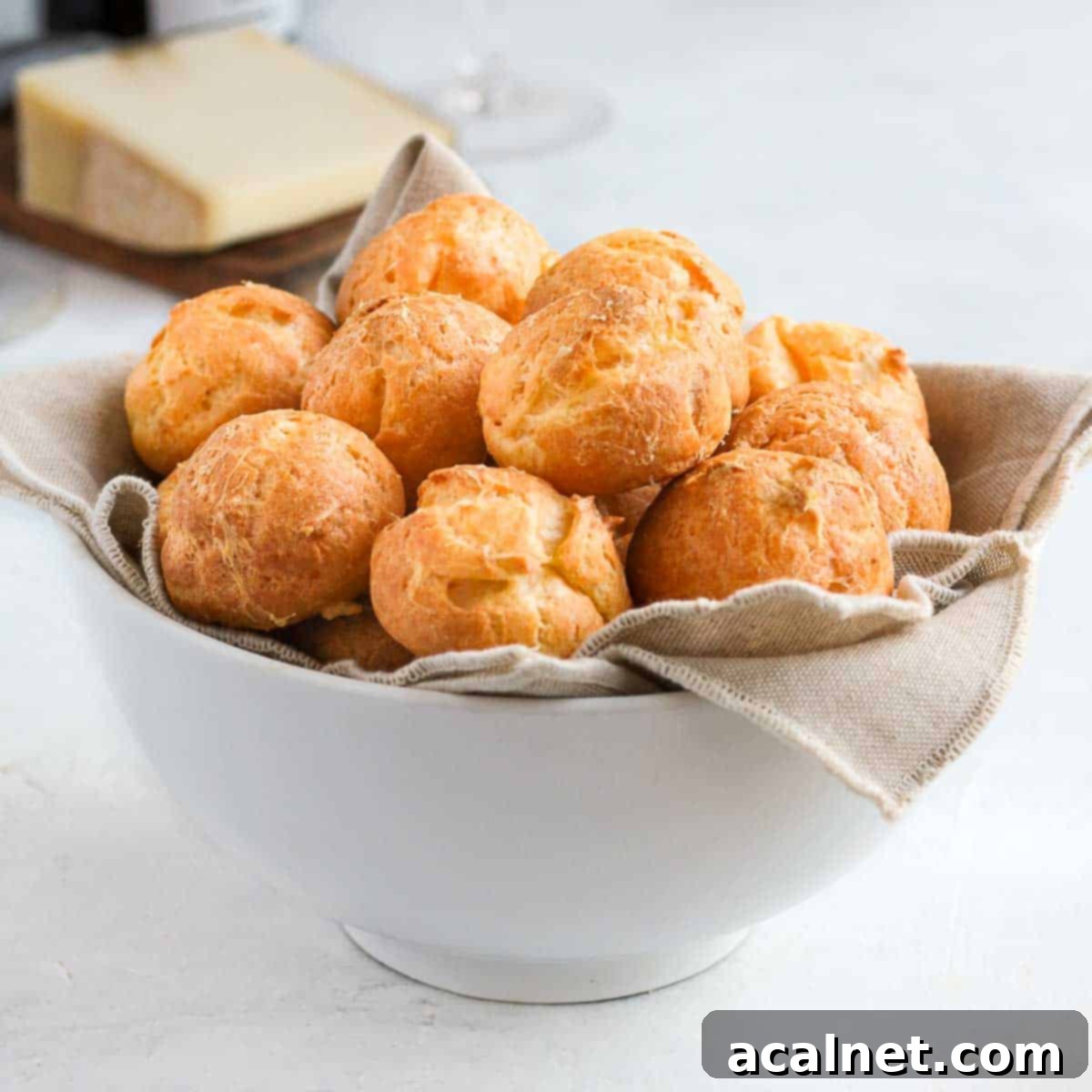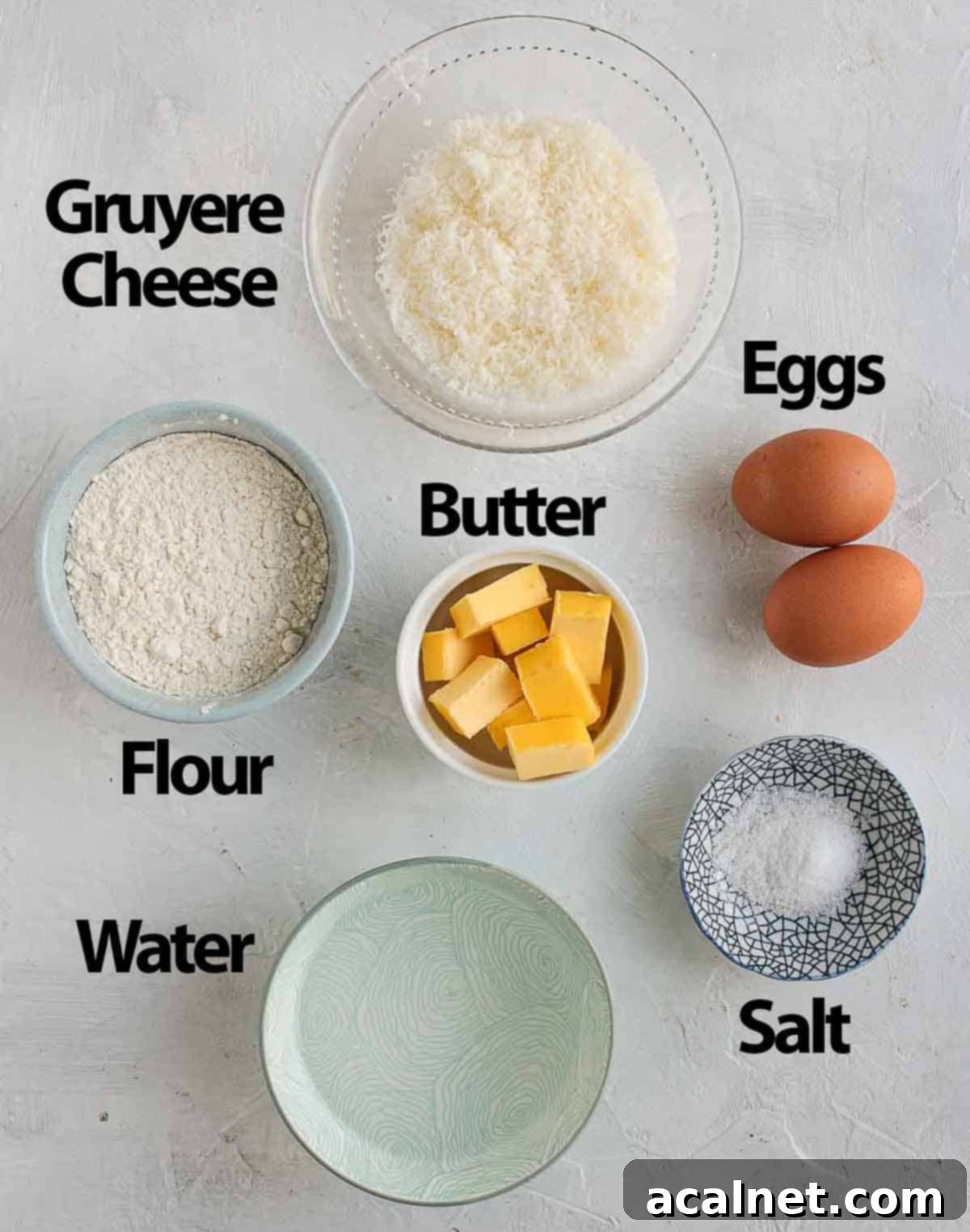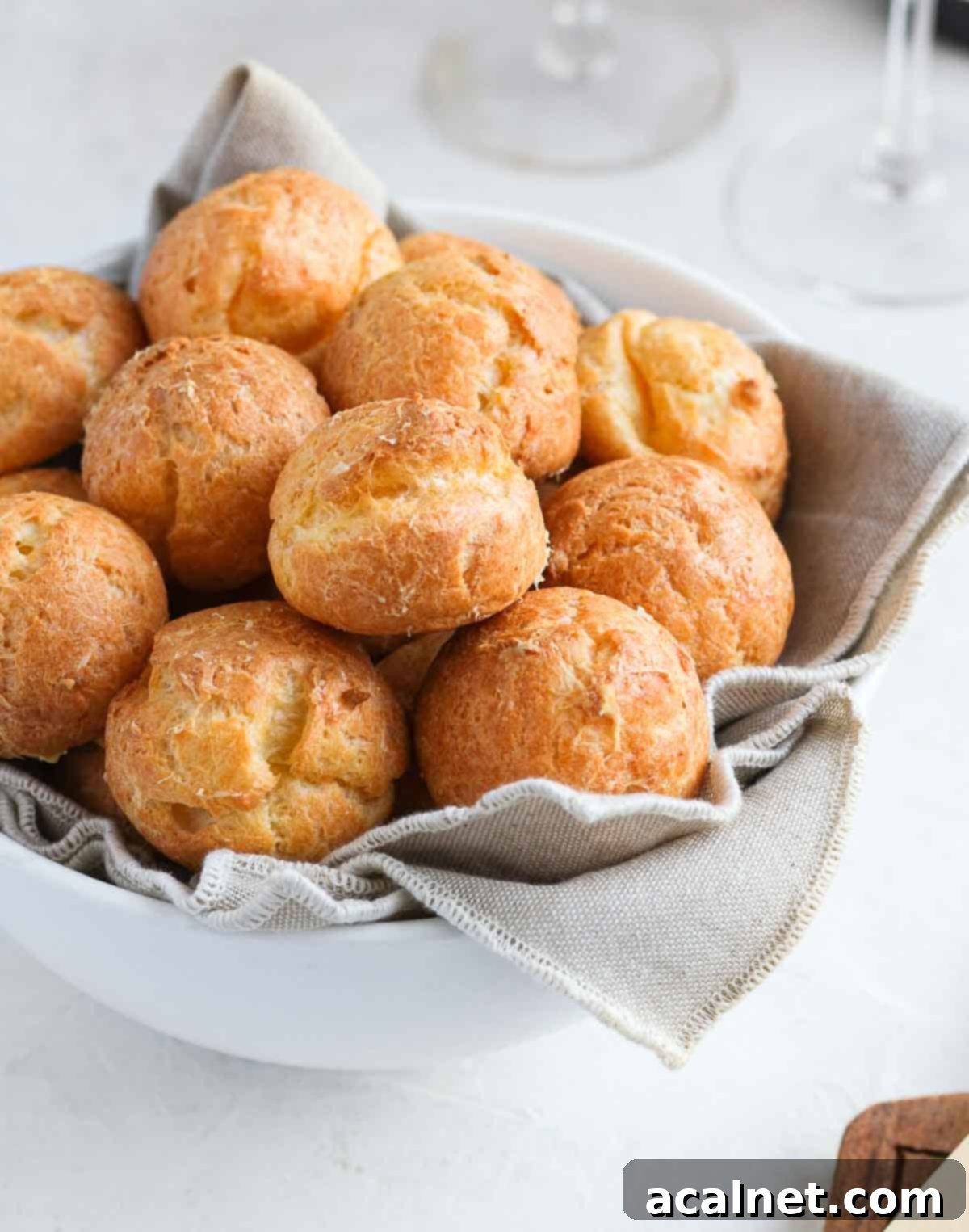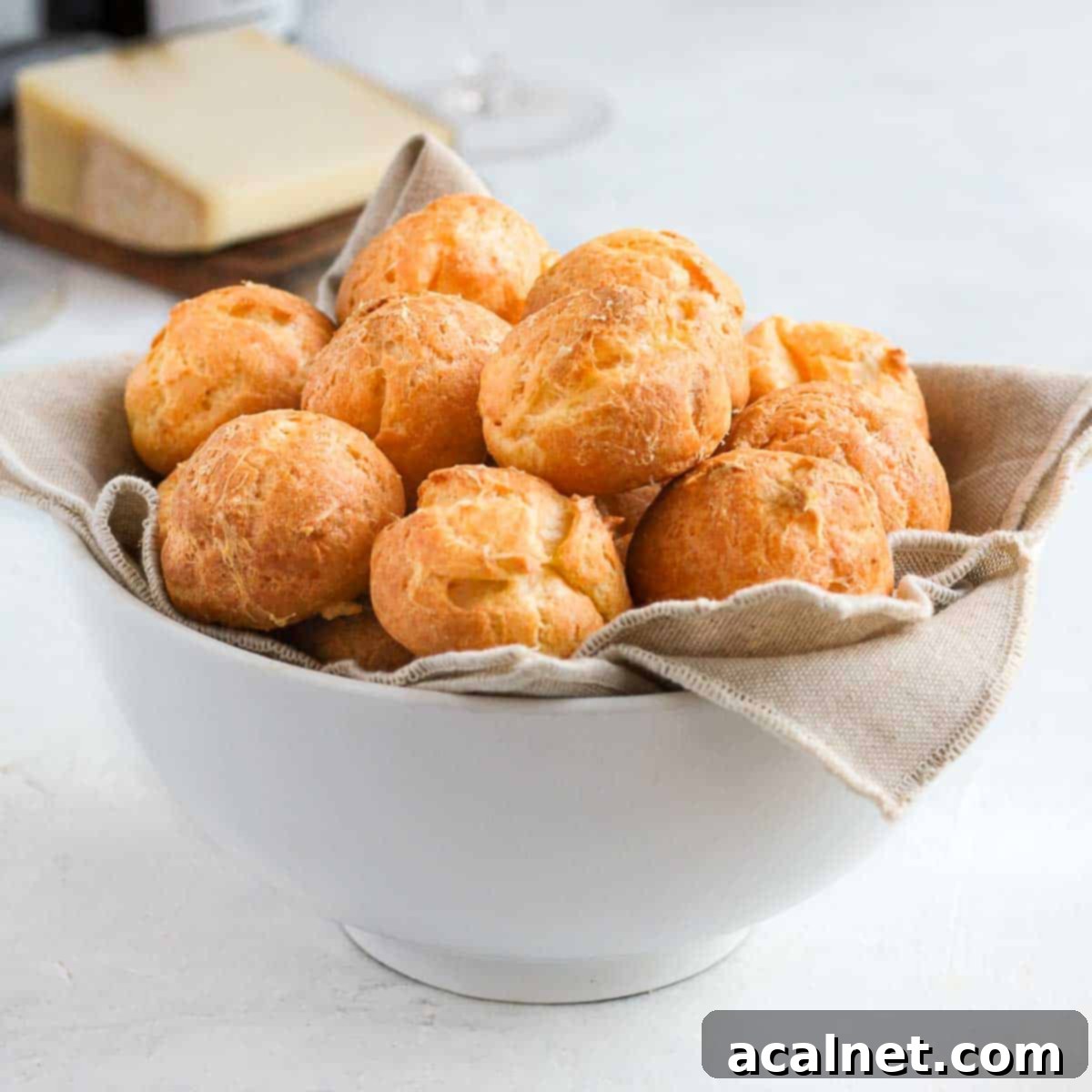Classic French Gougères: The Ultimate Fluffy Gruyère Cheese Puffs Recipe
Delight your guests with these exquisite Classic Cheese Gougères, also known as French Cheese Puffs. These light, airy, and irresistibly fluffy bites are generously packed with rich Gruyère cheese, making them a perfect savory treat. Crafted from delicate Choux Pastry, these delectable buns serve as an elegant appetizer for your next dinner party or a sophisticated finger food pairing for a wine tasting event. Prepare to impress with a recipe that is surprisingly easy to master!

This beloved recipe for French Cheese Puffs was originally shared in March 2019 and received a comprehensive update in April 2021 to ensure perfection and clarity for all home bakers.
Why You’ll Adore This Gougères Recipe
If the delicate texture of Choux Pastry combined with the rich flavor of cheese sounds like your idea of heaven, then these Gougères are about to become your new favorite savory bite. What makes them truly special? They are remarkably quick and easy to prepare, belying their sophisticated appearance. This makes them absolutely ideal for adding a touch of elegance to any fancy cocktail party, intimate gathering, or even just a casual evening snack. Their incredibly light and airy texture means you’ll find it hard to stop at just one, making them notoriously addictive!
These savory versions of a classic Choux à la Crème are, without a doubt, a personal favorite when it comes to finger foods. They are simply perfect for any upscale occasion – from holiday celebrations to engagement parties – or frankly, just because you’re in the mood for something truly delicious. Their versatility is unmatched; serve them warm straight from the oven for a sublime experience, or enjoy them at room temperature.
Beyond being a fantastic standalone snack, these French Cheese Puffs are the ultimate accompaniment to a crisp glass of wine, enhancing both the flavors of the wine and the gougères themselves. They also effortlessly elevate any charcuterie board, cheese platter, or grazing table, adding a touch of French culinary flair that is sure to impress.
What Exactly is a Gougère? Understanding the French Cheese Puff
A “Gougère” is a quintessential French savory choux puff, distinguished by the generous inclusion of grated cheese – most traditionally Gruyère – directly into the choux pastry batter. Hailing from the Burgundy region of France, these delightful little pastries are typically served as a light appetizer or as a charming accompaniment to wine tastings, where their airy texture and cheesy notes perfectly complement various vintages.
These elegant cheese buns are wonderfully versatile; they can be savored either warm, when their cheesy aroma is most potent and their texture most tender, or at room temperature. While often served plain to highlight their inherent deliciousness, Gougères also serve as an excellent base for more elaborate creations. For an even fancier bite, they can be filled with various preparations such as a delicate smoked salmon mousse, a rich mushroom cream, whipped goat cheese, or a vibrant basil pesto. They are often affectionately referred to as the savory counterpart to sweet Chouquettes (French sugar puffs) or simply as elegant Cheese Profiteroles.
Essential Ingredients for Perfect Gougères

The beauty of Gougères lies in their simplicity, utilizing many of the same core ingredients found in other classic Choux Pastry recipes, such as Choux au Craquelin, Chocolate Choux, or Coffee Choux Buns. The key difference for these savory delights is simply omitting the sugar and incorporating a generous amount of grated cheese instead.
Here’s a closer look at what goes into these delectable Gougères (for precise quantities, please refer to the recipe card below):
- Water: This is the primary liquid in our choux pastry. For an even richer result, you can substitute the water with full cream milk, or use a half-water, half-milk combination. I personally lean towards using water only, as it tends to yield an exceptionally light and crispy puff.
- Unsalted Butter: Essential for richness and flavor. Using unsalted butter gives you control over the overall saltiness of the dish. It can be used directly from the fridge or at room temperature, as it will be melted in the saucepan.
- Salt: A crucial flavor enhancer for any savory dish. I recommend a fine table salt here to ensure it dissolves quickly and evenly into the liquid, providing a consistent seasoning throughout the pastry.
- Plain / All-Purpose Flour: The structural backbone of our choux pastry. Always sift your flour before adding it to prevent any lumps and ensure a smooth, uniform batter.
- Eggs: Medium-sized and at room temperature are ideal. Eggs are vital for binding the dough, providing richness, and creating the steam that makes choux pastry puff up dramatically in the oven. The exact amount can vary slightly depending on their size and the dryness of your initial flour mixture, so it’s always best to add them gradually – see our expert tips below on how to achieve the perfect consistency.
- Grated Cheese: For this recipe, I’ve used finely grated Gruyère Cheese, which is the traditional choice and offers a wonderfully nutty, complex flavor that melts beautifully. However, don’t hesitate to experiment! You could easily use another firm, flavorful cheese like Parmesan, Comté, Emmental, or even a sharp Cheddar. A blend of cheeses can also create a unique and delightful flavor profile. Ensure the cheese is freshly grated for the best melting and flavor.
For an extra layer of flavor and warmth, consider adding a small pinch of Nutmeg Powder to your Gougères. The culinary possibilities don’t stop there; you can further personalize your cheese puffs with a dash of Cayenne Pepper or freshly ground Black Pepper for a subtle kick, a hint of Powdered Garlic for an aromatic touch, or even finely chopped fresh herbs like chives, parsley, or thyme for a burst of freshness.
Mastering French Cheese Puffs: A Step-by-Step Guide

Crafting the Perfect Choux Pastry Base
The process of making Gougères is fundamentally the same as preparing any other choux pastry recipe, with one delightful and significant addition: the cheese! For those new to the art of Pâte à Choux, the most critical concept to grasp is that this unique batter is “cooked” twice. First, it’s cooked on the stovetop, a crucial step where you aim to evaporate as much moisture as possible from the dough. This allows the dough to absorb more egg later, which then transforms into steam during the second cooking phase in the oven, causing those beautiful choux puffs to rise dramatically.
- Preparation: Begin by preheating your oven to 180 degrees Celsius (350 degrees Fahrenheit). Line a large baking tray with either baking paper, parchment paper, or a silicone baking mat. This ensures your Gougères won’t stick and will bake evenly.
- Photo 1: Initial Melt: In a small to medium saucepan, combine the Water, Butter, and Salt. Heat this mixture gently over medium heat until the butter has fully melted and the liquid is just beginning to simmer. There’s no need for a rolling boil; simply ensure all ingredients are well combined and the butter is completely incorporated. If you’re adding any optional spices like nutmeg or cayenne pepper, now is the perfect time to stir them in with the salt.
- Photo 2: Drying the Dough (Détrempe): Once the butter has melted and the liquid is simmering, remove the saucepan from the heat. Add all of the sifted Plain/All-Purpose Flour at once. Using a stiff, heat-proof silicone spatula or a sturdy wooden spoon, stir vigorously until the mixture comes together to form a rough ball of dough. Return the saucepan to medium heat and continue to cook the dough for a few minutes, stirring continuously. This step is vital for “drying out” the dough, evaporating excess moisture. To do this effectively, press the dough firmly against the bottom and sides of the pan, constantly turning it.
- Photo 3: Checking for Dryness: You’ll notice the dough will become thick and smooth, pulling away cleanly from the sides of the pan. A tell-tale sign that the batter has been sufficiently cooked and dried out is the formation of a thin film of dough on the bottom of the saucepan. This indicates that enough moisture has evaporated, setting the stage for perfect puffs.
- Cooling the Dough: Immediately transfer the hot dough into the bowl of your stand mixer, fitted with the paddle attachment. Mix on low to medium speed for about 5 minutes. This step is crucial for cooling down the dough slightly before adding the eggs, preventing them from scrambling. If you’re making the dough by hand, simply transfer it to a large mixing bowl and let it sit for 10 to 15 minutes to cool down before proceeding.
Achieving Perfect Consistency: Incorporating the Eggs
Adding the eggs is a delicate phase that dictates the final texture of your Gougères. Gradual incorporation and careful observation are key to achieving the ideal choux pastry consistency.
- Photo 4: Gradual Egg Addition: With the mixer running on low to medium speed, begin adding the whisked eggs gradually, a little at a time. I find it helpful to whisk the eggs in a separate bowl first, then slowly pour them in. Mix thoroughly after each addition until the egg is fully combined before adding more. Initially, the dough may appear to split or resist mixing, looking like a curdled mess. Don’t worry, this is entirely normal! Continue mixing, and it will eventually come back together into a smooth batter.
As mentioned earlier, the exact quantity of eggs can vary. Factors like the humidity of your kitchen, the brand of flour, and the size of your eggs all play a role. This is why adding eggs slowly and checking the batter’s consistency is paramount. Never rush this step!
The “Ribbon” Test for Perfect Choux Pastry: To determine if you’ve added enough eggs, perform the “ribbon” test. Dip a clean finger, or lift some batter with your spatula, and gently pull it upwards. Flip your finger or spatula upside down so the batter faces up. If the strand of choux pastry slowly falls back down on itself, creating a ‘V’ or ‘ribbon’ shape, your batter has the perfect consistency. If it remains stiff and upright, you need to add a little more egg. If it falls off too quickly and looks runny, you’ve added too much egg (a common mistake, often irreversible, so be cautious!).

The Cheesy Finish: Incorporating and Baking
- Photo 5: Smooth Batter: At this stage, you should have a smooth, thick batter that is slightly sticky to the touch and holds its shape well. This perfectly prepared pâte à choux is now ready for its star ingredient!
- Photo 6: Cheese Integration: Add the finely grated Gruyère Cheese to the choux pastry. Stir it gently for just a few seconds, only until the cheese is evenly combined throughout the batter. Overmixing here is unnecessary and can develop the gluten too much.
- Photo 7: Piping the Gougères: Transfer the choux dough into a pastry bag fitted with a large round nozzle. On your prepared baking tray, pipe small, uniform mounds of batter, ensuring you leave sufficient space between each choux. This space is crucial to allow them to puff up adequately without merging during baking. For an extra cheesy crust, you can optionally grate a little more cheese directly over the top of each piped choux before they go into the oven.
- Baking to Golden Perfection: Place the baking tray on the middle rack of your preheated oven and bake for 20 minutes. During this initial phase, it is absolutely critical NOT to open the oven door, as the steam needs to build up to create the characteristic hollow interior and dramatic puff. After 20 minutes, quickly open the oven door for just a couple of seconds to release some of the steam, then immediately close it again. Continue baking for an additional 5 to 10 minutes, or until the Gougères have fully puffed, turned a beautiful golden brown, and feel dry to the touch. This second baking phase helps to dry out the pastry and prevent it from collapsing.
- Cooling and Serving: Once baked, remove the Gougères from the oven and transfer them to a wire cooling rack. Allow them to cool down slightly before serving warm, or let them cool completely and store at room temperature until you’re ready to enjoy them.

Expert Tips & Troubleshooting for Perfect Gougères
Even though Gougères are relatively simple, mastering choux pastry can sometimes present challenges. Here are some pro tips and solutions to common issues to ensure your cheese puffs turn out perfectly every time:
- Pre-Whisk Your Eggs: Always whisk your eggs in a separate bowl before adding them to the choux pastry. This allows for more precise control over the amount added, making it easier to achieve the correct consistency and prevent accidental over-addition. Remember to stop adding eggs as soon as the batter reaches the right consistency, even if you have some egg mixture left over.
- Alternative Piping Methods: No pastry bag or piping tip? No problem! You can easily use a small ice cream scoop, a cookie scoop, or even two basic tablespoons to portion out the choux pastry onto your baking sheets. While the shape might not be as perfectly round, the taste and texture will still be incredible.
- Bake Longer Than You Think: One of the most common mistakes is underbaking choux pastry. It’s crucial to bake the cheese puffs for a bit longer than you might initially anticipate. This extended baking time is the best way to ensure they are fully dried out internally and will not collapse once removed from the oven.
- The Golden Rule: Do Not Open the Oven Door Too Early! This is perhaps the single most important tip for any choux pastry. Opening the oven door prematurely allows the built-up steam to escape, which is what gives choux its characteristic puff and hollow interior. If the steam escapes too soon, your Gougères will collapse and become dense. Resist the temptation to peek until at least the initial 20 minutes of baking are complete.
- Troubleshooting Collapsed or Unrisen Gougères: If your Gougères didn’t rise as expected or collapsed after baking, there are typically a few reasons:
- Insufficient Drying on the Stovetop: The dough must be thoroughly dried out on the stovetop to allow it to absorb enough egg and create sufficient steam for puffing.
- Incorrect Egg Quantity: Adding too little egg will result in a dry, dense pastry that can’t expand. Adding too much egg makes the batter too wet, preventing it from holding its structure and causing it to collapse. Always rely on the “ribbon” test for perfect consistency.
- Opening the Oven Door Too Soon: As mentioned, this is a critical error that releases vital steam, leading to deflated puffs.
- Uniform Sizing: Try to pipe your Gougères in consistent sizes. This ensures they bake evenly, preventing some from burning while others remain undercooked.
Gougères Recipe: Your Questions Answered
These French cheese puffs offer a unique and delightful sensory experience. They possess a wonderfully airy texture with a crisp, yet tender, sponge-like crust that gives way to a light, delicate interior. The dominant flavor is a rich, nutty cheese – typically Gruyère – perfectly balanced by the subtle savory notes of the choux pastry. If you notice a strong, eggy flavor, it’s often an indication that the Gougères are slightly underbaked and could benefit from a few extra minutes in the oven to fully dry out.
Absolutely! While Gruyère cheese is traditionally the star in Gougères, the recipe is incredibly forgiving and open to customization. You can certainly use any other firm, grated cheese that melts well and offers a robust flavor. Excellent alternatives include sharp Parmesan Cheese for a saltier, umami kick, Comté for a similar nutty depth, Emmental, or even a good quality sharp Cheddar for a more familiar, tangy profile. Feel free to mix and match different cheeses to create your own signature Gougère flavor!
Yes, indeed! While these cheese puffs are undeniably delicious on their own, they also serve as an exceptional base for creating decadent filled appetizers that will truly elevate your entertaining. The possibilities for fillings are virtually endless, allowing for incredible creativity. Here are just a few tantalizing ideas to get you started: a delicate Smoked Salmon Mousse, a rich and earthy Mushroom Cream, a tangy Whipped Goat Cheese (or other soft cheeses), or a vibrant, fresh Basil Pesto. Simply slice the cooled Gougères horizontally and spoon in your desired filling for an impressive gourmet bite.
Gougères are wonderfully versatile and can be served warm, lukewarm, or even cold, though many prefer them fresh from the oven for the best texture and aroma. The more pertinent question often revolves around what to drink with these delightful French cheese puffs! They are traditionally paired beautifully with a sophisticated Red Wine, especially lighter reds like Pinot Noir, or for a celebratory touch, a glass of crisp Champagne or sparkling wine. They also make a fantastic addition to any elegant grazing board, charcuterie platter, or cheese board, adding a touch of French sophistication to your spread.

Storing Your Gougères: Keeping Them Fresh
For the absolute best taste and texture, Gougères are truly at their peak when eaten very fresh, ideally as soon as they have cooled slightly after baking. Their delicate choux pastry can be sensitive to moisture. If you don’t plan to serve them immediately, it’s best to store them at room temperature in an airtight container for up to one day. It’s crucial to avoid refrigerating baked Gougères, as the humidity in the fridge will quickly cause them to become soggy and lose their delightful crispness and airy texture.
Freezing Gougères for Future Enjoyment
Gougères are a fantastic make-ahead appetizer, especially if you plan to host. While they are best enjoyed fresh, freezing is an excellent option for long-term storage. You can freeze Gougères both baked and unbaked, but I highly recommend freezing them unbaked. This method allows you to bake them fresh just before serving, yielding the best possible texture and flavor that rivals freshly made ones.
- Freezing Un-baked Gougères: To freeze unbaked, prepare the choux pastry and pipe the individual Gougères onto a baking tray lined with parchment paper. Place the entire tray in the freezer until the puffs are completely frozen solid (this prevents them from sticking together). Once frozen, transfer the solid Gougères into a freezer-safe bag or airtight container, removing as much air as possible. When you’re ready to serve, simply place the frozen Gougères back on a lined baking tray, optionally top with a little more grated cheese, and bake as instructed in the recipe. You will likely need to bake them for an additional 5 to 10 minutes, as they are going into the oven from frozen.
- Freezing Baked Gougères: If you must freeze them baked, first allow the puffs to cool down completely to room temperature. Then, arrange them in a single layer on a flat tray and freeze until solid. Once frozen, transfer them into a freezer bag or container. To serve, let them thaw at room temperature for a few hours, and then you can briefly reheat them in a preheated oven (around 150°C/300°F) for a few minutes to crisp them up. Be aware that Gougères frozen this way might be slightly softer or more prone to collapsing after thawing compared to those baked from frozen.

More Delicious Appetizer Ideas You’ll Love
If you enjoyed making and savoring these Gougères, you’re in for a treat! Here are more fantastic appetizer recipes from our kitchen that are perfect for entertaining or simply enjoying as a savory snack:
- Mini Cherry Tomato and Pesto Galettes
- Goat’s Cheese Zucchini Muffins
- Spinach and Ricotta Rolls
- Puff Pastry Mushroom Tart (originally Smoked Salmon Quiche, but link title updated for consistency with current text)
- Cheddar and Spinach Muffins
- Rosemary Focaccia
- Spanakopita Triangles
Made this recipe?
Let us know if you liked it by leaving a comment below, and tag us on Instagram @a.baking.journey with a photo of your delightful creation!
Recipe Card: Classic Gougères (French Cheese Puffs)

Gougères (French Cheese Puffs)
Print Recipe
Ingredients
- 125 ml (1/2 cup) Water , or half water, half milk for a richer flavor
- 60 gr (1/4 cup) Unsalted Butter
- 1/3 teasp. Salt
- 75 gr (1/2 cup) Plain/ All-Purpose Flour, sifted
- 2 Eggs, medium size, at room temperature, whisked lightly
- 20 gr (about 1/3 cup) Grated Gruyère Cheese , finely grated, plus extra for topping (optional)
- 1 pinch Nutmeg Powder, optional, for added warmth
Instructions
- Preheat your oven to 180°C (350°F) and line a large baking tray with parchment paper or a silicone baking mat (see note 1 for a helpful trick to keep the paper in place).
- In a medium saucepan, combine the Water, Butter, and Salt (and nutmeg, if you’re using it). Heat over medium heat until the butter has completely melted and the mixture just begins to simmer. Remove from heat immediately. Add all of the sifted Plain/All-Purpose Flour in one go.
- Using a sturdy wooden spoon or a stiff spatula, stir the mixture vigorously until it comes together to form a rough ball of dough. Return the saucepan to low to medium heat and continue to stir and cook the dough for 2-3 minutes, pressing it against the sides and bottom of the pan to dehydrate it as much as possible (see note 2 for detailed technique). You should see a thin film forming on the bottom of the pan.
- Transfer the hot dough into the bowl of your stand mixer fitted with the paddle attachment. Mix on medium-low speed for about 5 minutes to allow the dough to cool down slightly (see note 3 for hand-mixing alternative). This prevents the eggs from cooking when added.
- Begin slowly adding the lightly whisked Eggs, a little at a time (see note 4 for best practice). Mix well after each addition until the egg is fully incorporated before adding more. The dough might look like it’s splitting at first, but it will come back together. To check if you’ve added enough eggs, perform the “ribbon test”: dip a finger into the batter, pull it up, and flip your finger upwards. The batter should slowly fold back down on itself in a “V” shape (see note 5 for troubleshooting egg consistency).
- Add the finely Grated Gruyère Cheese to the choux batter and stir gently until it is just mixed through. Avoid overmixing.
- Transfer the choux batter into a pastry bag fitted with a large round piping tip (or use two spoons). Pipe small, uniform mounds of batter onto the prepared baking tray, ensuring you leave at least 2 inches of space between each choux to allow for proper expansion.
- Optional: For an extra cheesy crust and golden finish, sprinkle a little more grated Gruyère cheese over the top of each piped choux puff before baking.
- Bake for 20 minutes on the middle rack of your oven without opening the oven door at all. This crucial step allows steam to build up, creating the airy interior. After 20 minutes, quickly open the oven door for a couple of seconds to release excess steam, then immediately close it. Continue baking for an additional 5 to 10 minutes, or until the Gougères are beautifully puffed, deeply golden brown, and feel dry to the touch, indicating they are fully baked through.
- Remove from the oven and transfer to a wire rack to cool down slightly. Serve warm for the best experience, or leave to cool completely and store at room temperature until ready to serve.
Would you like to save this recipe?
We’ll email this post to you, so you can come back to it later!
Notes
Ingredients Notes:
- Liquid Base: For a richer choux pastry with a slightly softer interior, you can replace the water with full cream milk, or use a 50/50 mix of milk and water. Using only water will generally yield a lighter and crispier puff, which is often preferred for Gougères.
- Egg Quantity: The precise number of eggs needed can vary. This is due to factors like the size of your eggs (medium vs. large) and how much moisture was evaporated from the dough on the stove. Always add eggs gradually, a little at a time, and stop as soon as the batter reaches the correct “ribbon” consistency, even if you have a bit of whisked egg mixture left over. It’s better to err on the side of slightly less egg than too much.
Instruction Notes:
- Securing Parchment Paper: To prevent your baking paper or silicone mat from shifting while you’re piping the Gougères, simply place a very small dab of choux batter in each of the four corners of your baking tray, then press the paper firmly over these dabs. This will act as a natural adhesive.
- Drying Out the Dough: This stovetop step is absolutely critical for choux pastry success. A highly effective technique to dry out the dough is to continuously “rub” or press the batter against the sides and bottom of the pot with your wooden spoon or spatula. Keep moving and pressing the dough until a thin film forms on the bottom of the pan, indicating significant moisture has been removed. This ensures the dough can properly absorb the eggs and create enough steam to puff.
- Cooling Process: If you don’t have a stand mixer, or simply prefer to work by hand, after cooking the dough on the stove, transfer it to a large mixing bowl. Allow it to cool for about 10 to 15 minutes, stirring occasionally, before adding the eggs. This cooling step is essential to prevent the hot dough from cooking the eggs prematurely, which would result in a lumpy, unusable batter.
- Pre-Whisking Eggs: Lightly whisking your eggs in a separate bowl before adding them to the choux pastry makes their incorporation much smoother and more even. It also gives you much greater control over the exact amount of egg you add, which is key to achieving the perfect batter consistency.
- Egg Consistency Test: The “ribbon” test is your best friend here! If, after adding eggs, the batter still feels very stiff and doesn’t fall back down on itself when you lift it, continue adding a very small amount more of whisked egg (perhaps just a teaspoon at a time). Mix thoroughly and re-test. Be extremely cautious not to add too much; a runny batter cannot be fixed. The ideal consistency is a soft, shiny batter that slowly detaches and forms a ‘V’ shape.
Nutrition (per serving)
